AB224 Microeconomics: Evaluating Price Floors & Market Outcomes
VerifiedAdded on 2023/04/21
|7
|1707
|137
Homework Assignment
AI Summary
This assignment focuses on analyzing the effects of a price floor on consumer surplus, producer surplus, and total surplus in a perfectly competitive market. It examines a scenario where the government sets a price floor for gosum berries above the equilibrium price, leading to changes in market dynamics. The assignment involves calculating consumer and producer surplus before and after the implementation of the price floor, as well as determining the cost to the government for purchasing surplus berries. Furthermore, it assesses the overall impact on the economy, considering the tax implications and the resulting reduction in total surplus due to the price floor intervention. The analysis highlights the trade-offs between supporting producers and the potential inefficiencies introduced into the market.
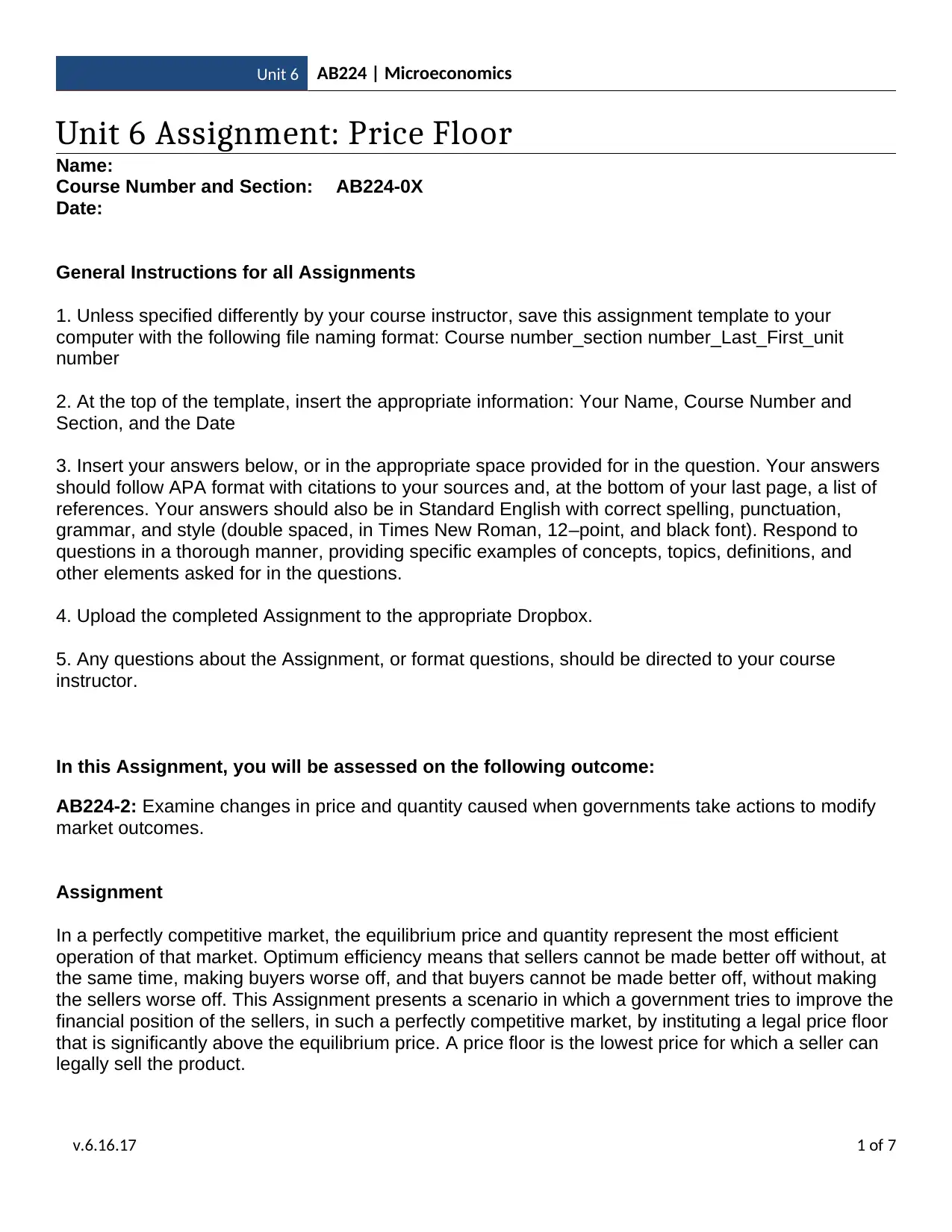
Unit 6 AB224 | Microeconomics
Unit 6 Assignment: Price Floor
Name:
Course Number and Section: AB224-0X
Date:
General Instructions for all Assignments
1. Unless specified differently by your course instructor, save this assignment template to your
computer with the following file naming format: Course number_section number_Last_First_unit
number
2. At the top of the template, insert the appropriate information: Your Name, Course Number and
Section, and the Date
3. Insert your answers below, or in the appropriate space provided for in the question. Your answers
should follow APA format with citations to your sources and, at the bottom of your last page, a list of
references. Your answers should also be in Standard English with correct spelling, punctuation,
grammar, and style (double spaced, in Times New Roman, 12–point, and black font). Respond to
questions in a thorough manner, providing specific examples of concepts, topics, definitions, and
other elements asked for in the questions.
4. Upload the completed Assignment to the appropriate Dropbox.
5. Any questions about the Assignment, or format questions, should be directed to your course
instructor.
In this Assignment, you will be assessed on the following outcome:
AB224-2: Examine changes in price and quantity caused when governments take actions to modify
market outcomes.
Assignment
In a perfectly competitive market, the equilibrium price and quantity represent the most efficient
operation of that market. Optimum efficiency means that sellers cannot be made better off without, at
the same time, making buyers worse off, and that buyers cannot be made better off, without making
the sellers worse off. This Assignment presents a scenario in which a government tries to improve the
financial position of the sellers, in such a perfectly competitive market, by instituting a legal price floor
that is significantly above the equilibrium price. A price floor is the lowest price for which a seller can
legally sell the product.
v.6.16.17 1 of 7
Unit 6 Assignment: Price Floor
Name:
Course Number and Section: AB224-0X
Date:
General Instructions for all Assignments
1. Unless specified differently by your course instructor, save this assignment template to your
computer with the following file naming format: Course number_section number_Last_First_unit
number
2. At the top of the template, insert the appropriate information: Your Name, Course Number and
Section, and the Date
3. Insert your answers below, or in the appropriate space provided for in the question. Your answers
should follow APA format with citations to your sources and, at the bottom of your last page, a list of
references. Your answers should also be in Standard English with correct spelling, punctuation,
grammar, and style (double spaced, in Times New Roman, 12–point, and black font). Respond to
questions in a thorough manner, providing specific examples of concepts, topics, definitions, and
other elements asked for in the questions.
4. Upload the completed Assignment to the appropriate Dropbox.
5. Any questions about the Assignment, or format questions, should be directed to your course
instructor.
In this Assignment, you will be assessed on the following outcome:
AB224-2: Examine changes in price and quantity caused when governments take actions to modify
market outcomes.
Assignment
In a perfectly competitive market, the equilibrium price and quantity represent the most efficient
operation of that market. Optimum efficiency means that sellers cannot be made better off without, at
the same time, making buyers worse off, and that buyers cannot be made better off, without making
the sellers worse off. This Assignment presents a scenario in which a government tries to improve the
financial position of the sellers, in such a perfectly competitive market, by instituting a legal price floor
that is significantly above the equilibrium price. A price floor is the lowest price for which a seller can
legally sell the product.
v.6.16.17 1 of 7
Paraphrase This Document
Need a fresh take? Get an instant paraphrase of this document with our AI Paraphraser
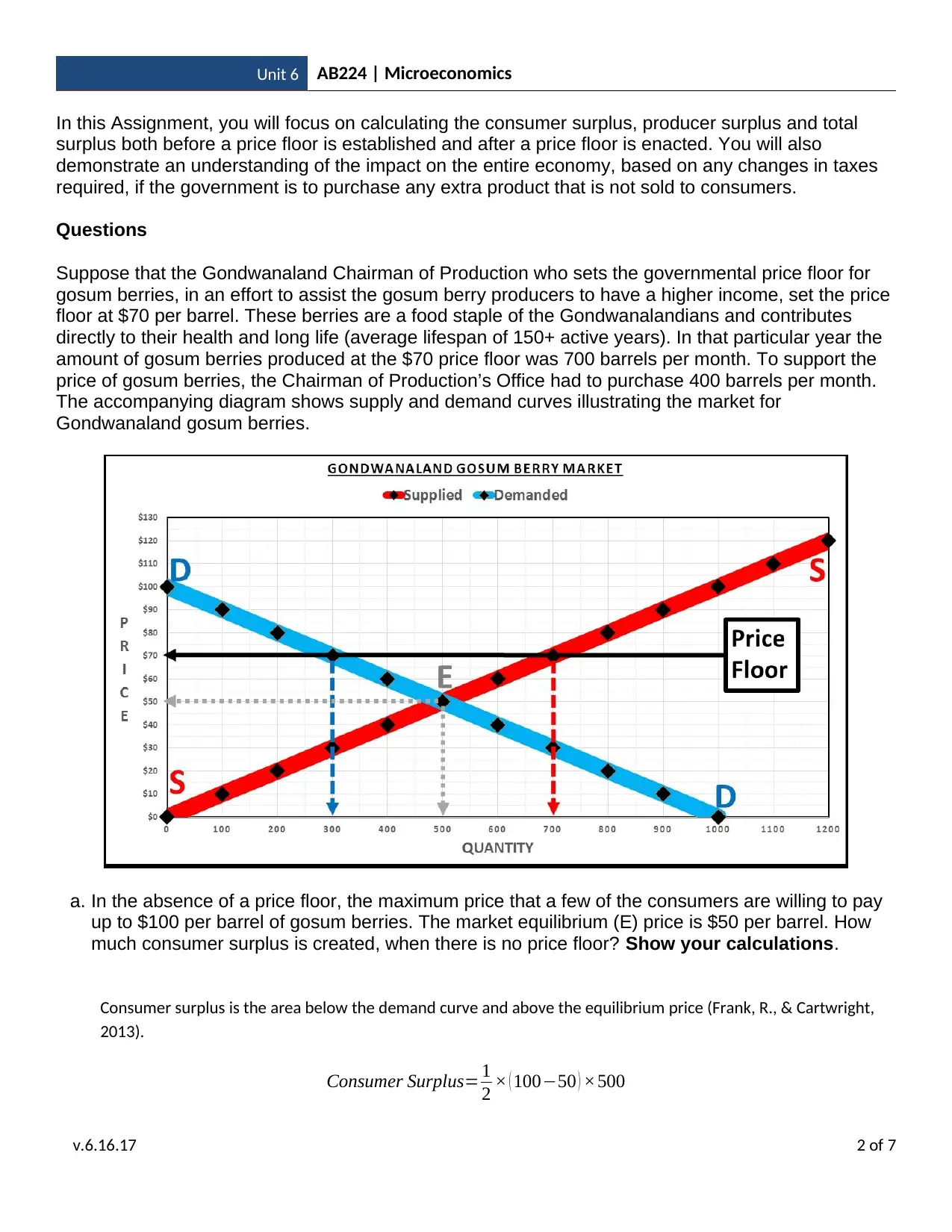
Unit 6 AB224 | Microeconomics
In this Assignment, you will focus on calculating the consumer surplus, producer surplus and total
surplus both before a price floor is established and after a price floor is enacted. You will also
demonstrate an understanding of the impact on the entire economy, based on any changes in taxes
required, if the government is to purchase any extra product that is not sold to consumers.
Questions
Suppose that the Gondwanaland Chairman of Production who sets the governmental price floor for
gosum berries, in an effort to assist the gosum berry producers to have a higher income, set the price
floor at $70 per barrel. These berries are a food staple of the Gondwanalandians and contributes
directly to their health and long life (average lifespan of 150+ active years). In that particular year the
amount of gosum berries produced at the $70 price floor was 700 barrels per month. To support the
price of gosum berries, the Chairman of Production’s Office had to purchase 400 barrels per month.
The accompanying diagram shows supply and demand curves illustrating the market for
Gondwanaland gosum berries.
a. In the absence of a price floor, the maximum price that a few of the consumers are willing to pay
up to $100 per barrel of gosum berries. The market equilibrium (E) price is $50 per barrel. How
much consumer surplus is created, when there is no price floor? Show your calculations.
Consumer surplus is the area below the demand curve and above the equilibrium price (Frank, R., & Cartwright,
2013).
Consumer Surplus= 1
2 × ( 100−50 ) ×500
v.6.16.17 2 of 7
In this Assignment, you will focus on calculating the consumer surplus, producer surplus and total
surplus both before a price floor is established and after a price floor is enacted. You will also
demonstrate an understanding of the impact on the entire economy, based on any changes in taxes
required, if the government is to purchase any extra product that is not sold to consumers.
Questions
Suppose that the Gondwanaland Chairman of Production who sets the governmental price floor for
gosum berries, in an effort to assist the gosum berry producers to have a higher income, set the price
floor at $70 per barrel. These berries are a food staple of the Gondwanalandians and contributes
directly to their health and long life (average lifespan of 150+ active years). In that particular year the
amount of gosum berries produced at the $70 price floor was 700 barrels per month. To support the
price of gosum berries, the Chairman of Production’s Office had to purchase 400 barrels per month.
The accompanying diagram shows supply and demand curves illustrating the market for
Gondwanaland gosum berries.
a. In the absence of a price floor, the maximum price that a few of the consumers are willing to pay
up to $100 per barrel of gosum berries. The market equilibrium (E) price is $50 per barrel. How
much consumer surplus is created, when there is no price floor? Show your calculations.
Consumer surplus is the area below the demand curve and above the equilibrium price (Frank, R., & Cartwright,
2013).
Consumer Surplus= 1
2 × ( 100−50 ) ×500
v.6.16.17 2 of 7
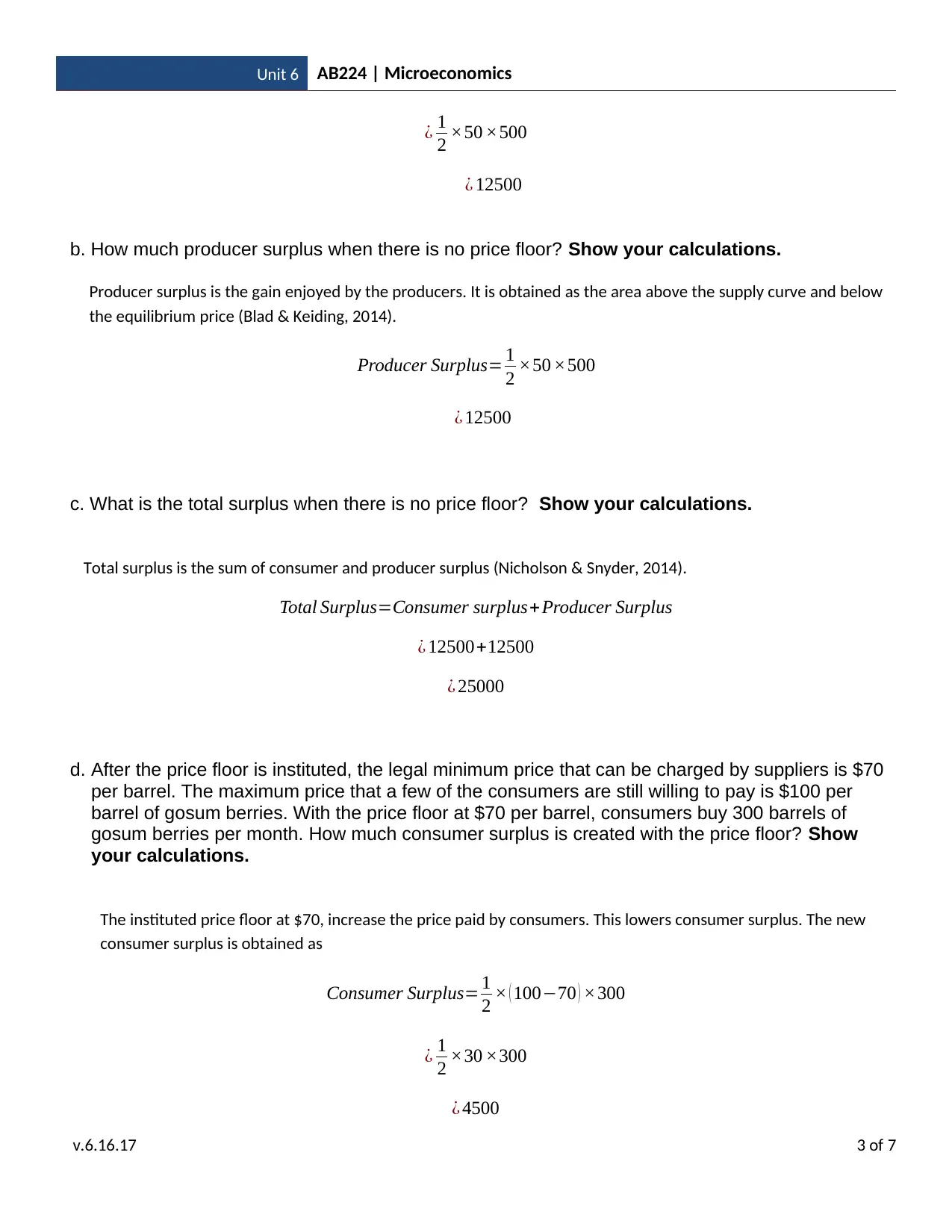
Unit 6 AB224 | Microeconomics
¿ 1
2 ×50 ×500
¿ 12500
b. How much producer surplus when there is no price floor? Show your calculations.
Producer surplus is the gain enjoyed by the producers. It is obtained as the area above the supply curve and below
the equilibrium price (Blad & Keiding, 2014).
Producer Surplus= 1
2 ×50 ×500
¿ 12500
c. What is the total surplus when there is no price floor? Show your calculations.
Total surplus is the sum of consumer and producer surplus (Nicholson & Snyder, 2014).
Total Surplus=Consumer surplus+Producer Surplus
¿ 12500+12500
¿ 25000
d. After the price floor is instituted, the legal minimum price that can be charged by suppliers is $70
per barrel. The maximum price that a few of the consumers are still willing to pay is $100 per
barrel of gosum berries. With the price floor at $70 per barrel, consumers buy 300 barrels of
gosum berries per month. How much consumer surplus is created with the price floor? Show
your calculations.
The instituted price floor at $70, increase the price paid by consumers. This lowers consumer surplus. The new
consumer surplus is obtained as
Consumer Surplus= 1
2 × ( 100−70 ) ×300
¿ 1
2 ×30 ×300
¿ 4500
v.6.16.17 3 of 7
¿ 1
2 ×50 ×500
¿ 12500
b. How much producer surplus when there is no price floor? Show your calculations.
Producer surplus is the gain enjoyed by the producers. It is obtained as the area above the supply curve and below
the equilibrium price (Blad & Keiding, 2014).
Producer Surplus= 1
2 ×50 ×500
¿ 12500
c. What is the total surplus when there is no price floor? Show your calculations.
Total surplus is the sum of consumer and producer surplus (Nicholson & Snyder, 2014).
Total Surplus=Consumer surplus+Producer Surplus
¿ 12500+12500
¿ 25000
d. After the price floor is instituted, the legal minimum price that can be charged by suppliers is $70
per barrel. The maximum price that a few of the consumers are still willing to pay is $100 per
barrel of gosum berries. With the price floor at $70 per barrel, consumers buy 300 barrels of
gosum berries per month. How much consumer surplus is created with the price floor? Show
your calculations.
The instituted price floor at $70, increase the price paid by consumers. This lowers consumer surplus. The new
consumer surplus is obtained as
Consumer Surplus= 1
2 × ( 100−70 ) ×300
¿ 1
2 ×30 ×300
¿ 4500
v.6.16.17 3 of 7
⊘ This is a preview!⊘
Do you want full access?
Subscribe today to unlock all pages.

Trusted by 1+ million students worldwide
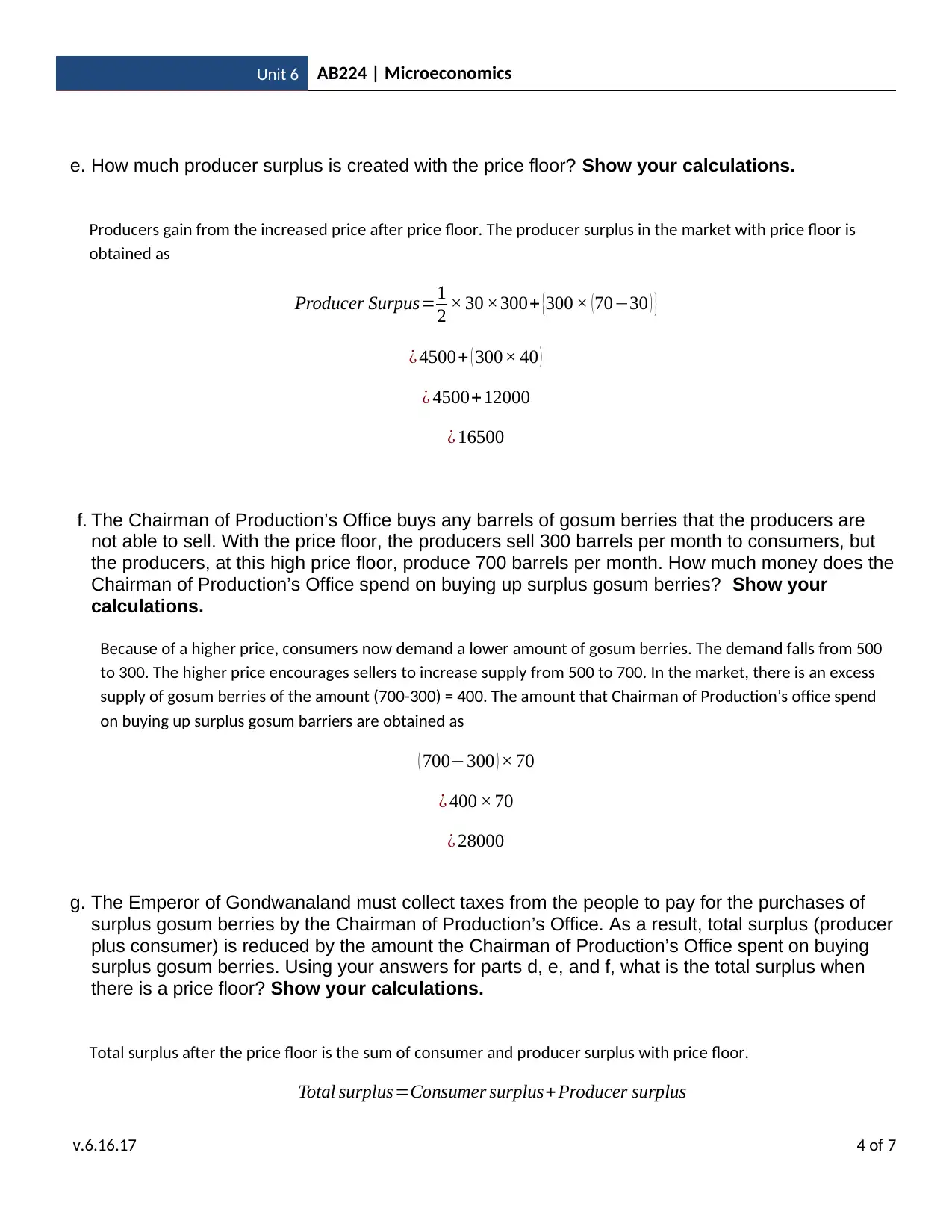
Unit 6 AB224 | Microeconomics
e. How much producer surplus is created with the price floor? Show your calculations.
Producers gain from the increased price after price floor. The producer surplus in the market with price floor is
obtained as
Producer Surpus=1
2 × 30 ×300+ {300 × ( 70−30 ) }
¿ 4500+ ( 300× 40 )
¿ 4500+12000
¿ 16500
f. The Chairman of Production’s Office buys any barrels of gosum berries that the producers are
not able to sell. With the price floor, the producers sell 300 barrels per month to consumers, but
the producers, at this high price floor, produce 700 barrels per month. How much money does the
Chairman of Production’s Office spend on buying up surplus gosum berries? Show your
calculations.
Because of a higher price, consumers now demand a lower amount of gosum berries. The demand falls from 500
to 300. The higher price encourages sellers to increase supply from 500 to 700. In the market, there is an excess
supply of gosum berries of the amount (700-300) = 400. The amount that Chairman of Production’s office spend
on buying up surplus gosum barriers are obtained as
( 700−300 ) × 70
¿ 400 × 70
¿ 28000
g. The Emperor of Gondwanaland must collect taxes from the people to pay for the purchases of
surplus gosum berries by the Chairman of Production’s Office. As a result, total surplus (producer
plus consumer) is reduced by the amount the Chairman of Production’s Office spent on buying
surplus gosum berries. Using your answers for parts d, e, and f, what is the total surplus when
there is a price floor? Show your calculations.
Total surplus after the price floor is the sum of consumer and producer surplus with price floor.
Total surplus=Consumer surplus+ Producer surplus
v.6.16.17 4 of 7
e. How much producer surplus is created with the price floor? Show your calculations.
Producers gain from the increased price after price floor. The producer surplus in the market with price floor is
obtained as
Producer Surpus=1
2 × 30 ×300+ {300 × ( 70−30 ) }
¿ 4500+ ( 300× 40 )
¿ 4500+12000
¿ 16500
f. The Chairman of Production’s Office buys any barrels of gosum berries that the producers are
not able to sell. With the price floor, the producers sell 300 barrels per month to consumers, but
the producers, at this high price floor, produce 700 barrels per month. How much money does the
Chairman of Production’s Office spend on buying up surplus gosum berries? Show your
calculations.
Because of a higher price, consumers now demand a lower amount of gosum berries. The demand falls from 500
to 300. The higher price encourages sellers to increase supply from 500 to 700. In the market, there is an excess
supply of gosum berries of the amount (700-300) = 400. The amount that Chairman of Production’s office spend
on buying up surplus gosum barriers are obtained as
( 700−300 ) × 70
¿ 400 × 70
¿ 28000
g. The Emperor of Gondwanaland must collect taxes from the people to pay for the purchases of
surplus gosum berries by the Chairman of Production’s Office. As a result, total surplus (producer
plus consumer) is reduced by the amount the Chairman of Production’s Office spent on buying
surplus gosum berries. Using your answers for parts d, e, and f, what is the total surplus when
there is a price floor? Show your calculations.
Total surplus after the price floor is the sum of consumer and producer surplus with price floor.
Total surplus=Consumer surplus+ Producer surplus
v.6.16.17 4 of 7
Paraphrase This Document
Need a fresh take? Get an instant paraphrase of this document with our AI Paraphraser
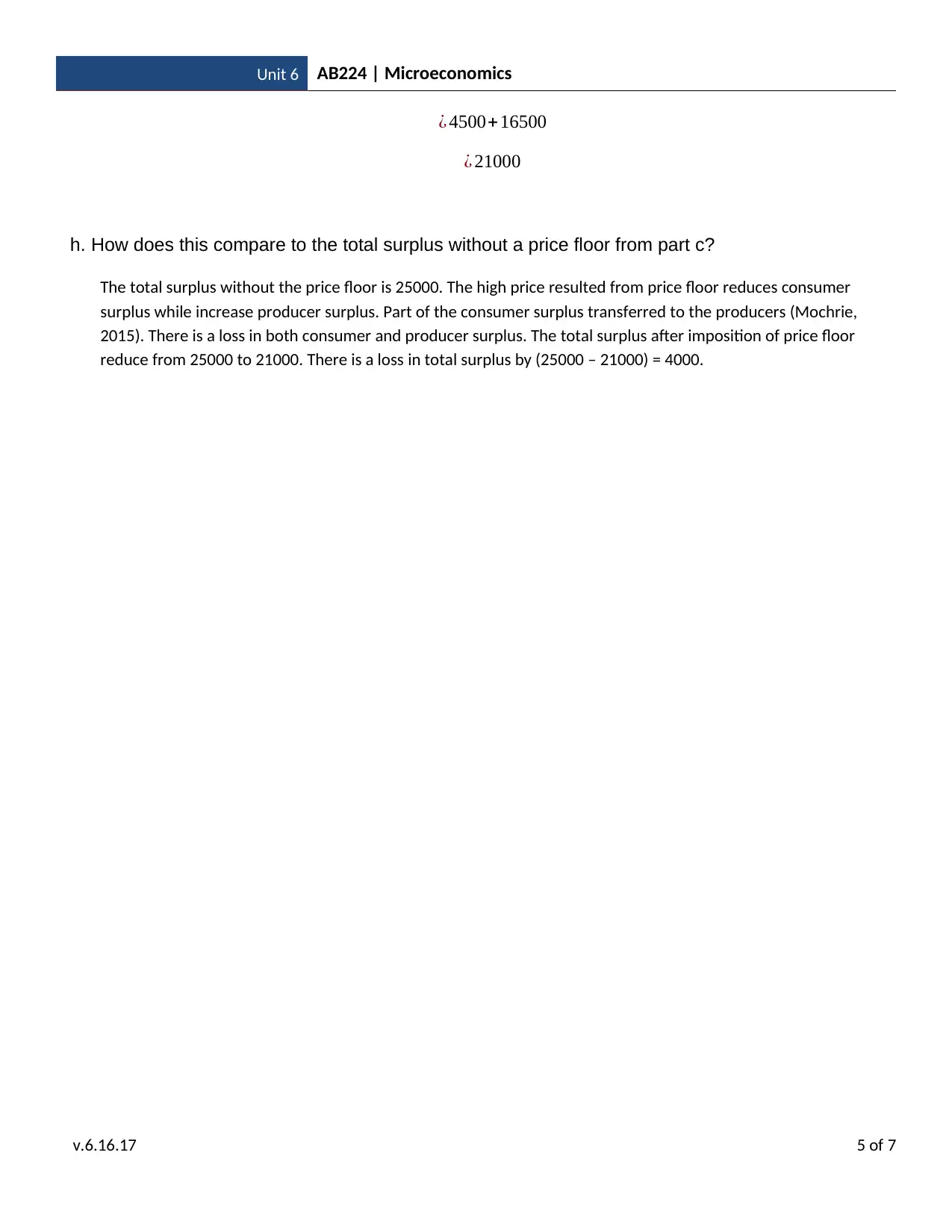
Unit 6 AB224 | Microeconomics
¿ 4500+16500
¿ 21000
h. How does this compare to the total surplus without a price floor from part c?
The total surplus without the price floor is 25000. The high price resulted from price floor reduces consumer
surplus while increase producer surplus. Part of the consumer surplus transferred to the producers (Mochrie,
2015). There is a loss in both consumer and producer surplus. The total surplus after imposition of price floor
reduce from 25000 to 21000. There is a loss in total surplus by (25000 – 21000) = 4000.
v.6.16.17 5 of 7
¿ 4500+16500
¿ 21000
h. How does this compare to the total surplus without a price floor from part c?
The total surplus without the price floor is 25000. The high price resulted from price floor reduces consumer
surplus while increase producer surplus. Part of the consumer surplus transferred to the producers (Mochrie,
2015). There is a loss in both consumer and producer surplus. The total surplus after imposition of price floor
reduce from 25000 to 21000. There is a loss in total surplus by (25000 – 21000) = 4000.
v.6.16.17 5 of 7
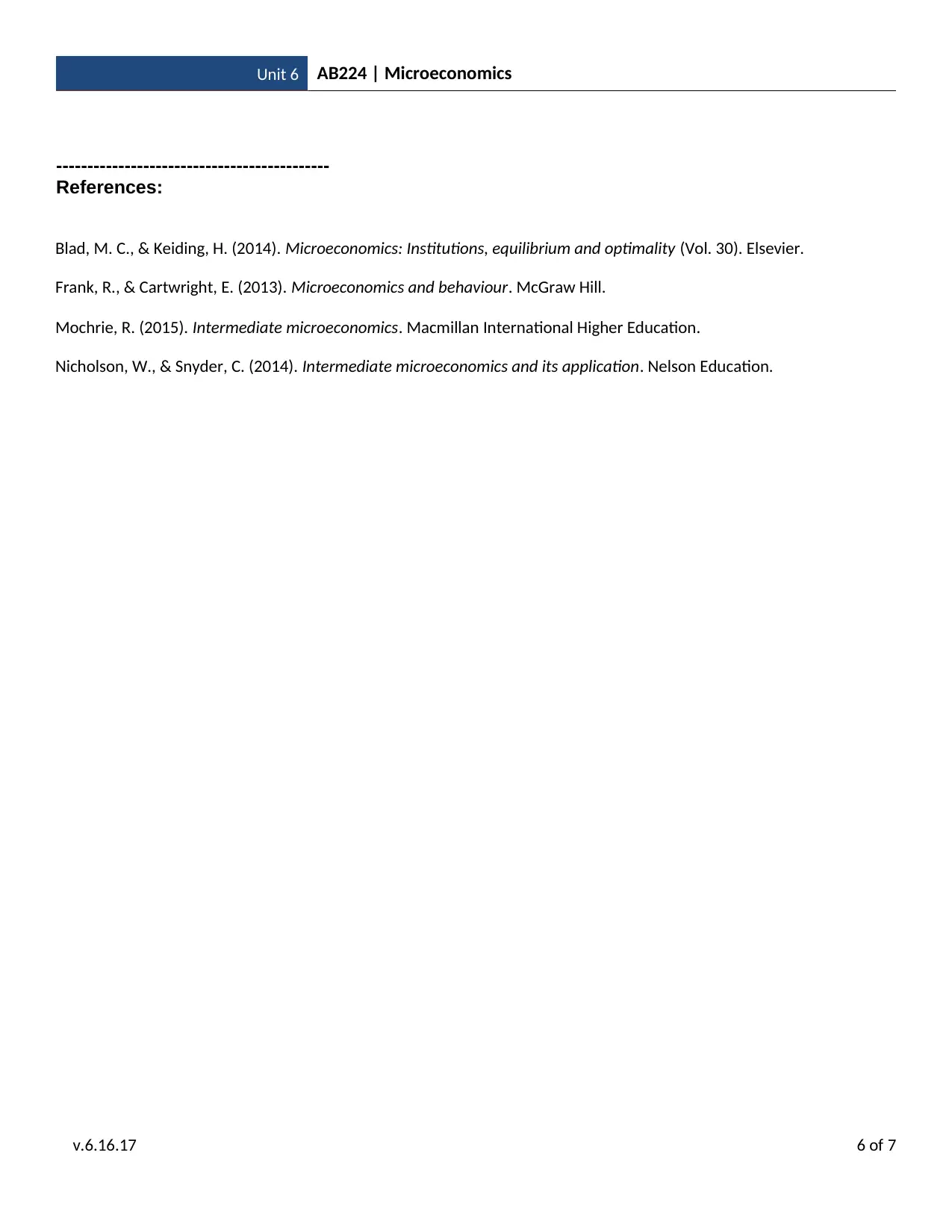
Unit 6 AB224 | Microeconomics
--------------------------------------------
References:
Blad, M. C., & Keiding, H. (2014). Microeconomics: Institutions, equilibrium and optimality (Vol. 30). Elsevier.
Frank, R., & Cartwright, E. (2013). Microeconomics and behaviour. McGraw Hill.
Mochrie, R. (2015). Intermediate microeconomics. Macmillan International Higher Education.
Nicholson, W., & Snyder, C. (2014). Intermediate microeconomics and its application. Nelson Education.
v.6.16.17 6 of 7
--------------------------------------------
References:
Blad, M. C., & Keiding, H. (2014). Microeconomics: Institutions, equilibrium and optimality (Vol. 30). Elsevier.
Frank, R., & Cartwright, E. (2013). Microeconomics and behaviour. McGraw Hill.
Mochrie, R. (2015). Intermediate microeconomics. Macmillan International Higher Education.
Nicholson, W., & Snyder, C. (2014). Intermediate microeconomics and its application. Nelson Education.
v.6.16.17 6 of 7
⊘ This is a preview!⊘
Do you want full access?
Subscribe today to unlock all pages.

Trusted by 1+ million students worldwide
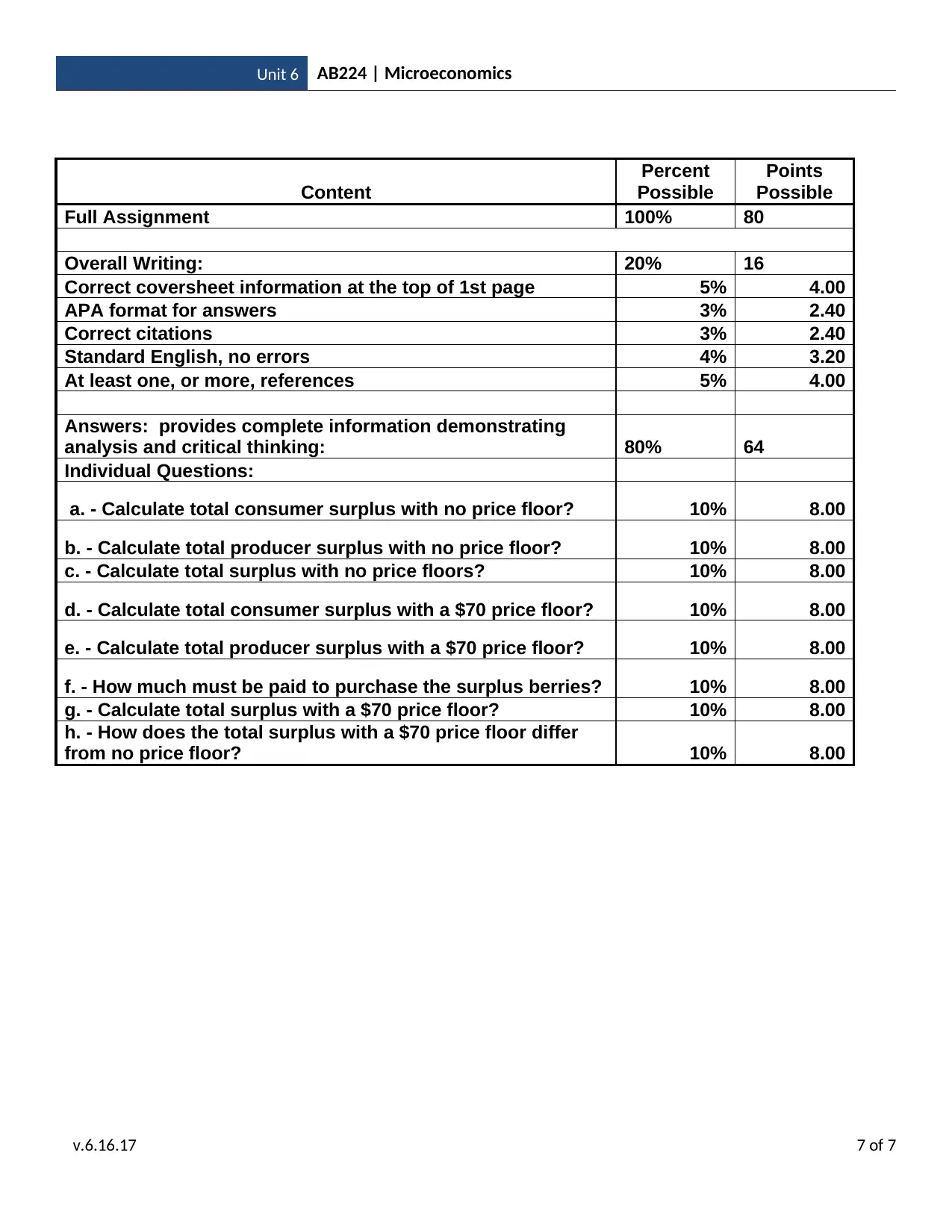
Unit 6 AB224 | Microeconomics
Content
Percent
Possible
Points
Possible
Full Assignment 100% 80
Overall Writing: 20% 16
Correct coversheet information at the top of 1st page 5% 4.00
APA format for answers 3% 2.40
Correct citations 3% 2.40
Standard English, no errors 4% 3.20
At least one, or more, references 5% 4.00
Answers: provides complete information demonstrating
analysis and critical thinking: 80% 64
Individual Questions:
a. - Calculate total consumer surplus with no price floor? 10% 8.00
b. - Calculate total producer surplus with no price floor? 10% 8.00
c. - Calculate total surplus with no price floors? 10% 8.00
d. - Calculate total consumer surplus with a $70 price floor? 10% 8.00
e. - Calculate total producer surplus with a $70 price floor? 10% 8.00
f. - How much must be paid to purchase the surplus berries? 10% 8.00
g. - Calculate total surplus with a $70 price floor? 10% 8.00
h. - How does the total surplus with a $70 price floor differ
from no price floor? 10% 8.00
v.6.16.17 7 of 7
Content
Percent
Possible
Points
Possible
Full Assignment 100% 80
Overall Writing: 20% 16
Correct coversheet information at the top of 1st page 5% 4.00
APA format for answers 3% 2.40
Correct citations 3% 2.40
Standard English, no errors 4% 3.20
At least one, or more, references 5% 4.00
Answers: provides complete information demonstrating
analysis and critical thinking: 80% 64
Individual Questions:
a. - Calculate total consumer surplus with no price floor? 10% 8.00
b. - Calculate total producer surplus with no price floor? 10% 8.00
c. - Calculate total surplus with no price floors? 10% 8.00
d. - Calculate total consumer surplus with a $70 price floor? 10% 8.00
e. - Calculate total producer surplus with a $70 price floor? 10% 8.00
f. - How much must be paid to purchase the surplus berries? 10% 8.00
g. - Calculate total surplus with a $70 price floor? 10% 8.00
h. - How does the total surplus with a $70 price floor differ
from no price floor? 10% 8.00
v.6.16.17 7 of 7
1 out of 7
Your All-in-One AI-Powered Toolkit for Academic Success.
+13062052269
info@desklib.com
Available 24*7 on WhatsApp / Email
![[object Object]](/_next/static/media/star-bottom.7253800d.svg)
Unlock your academic potential
Copyright © 2020–2025 A2Z Services. All Rights Reserved. Developed and managed by ZUCOL.


